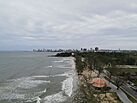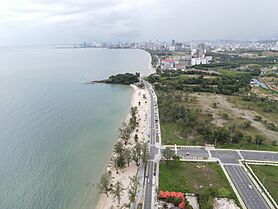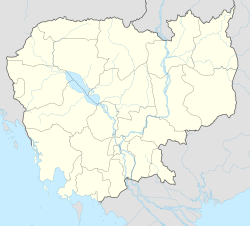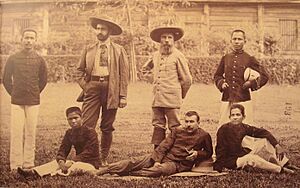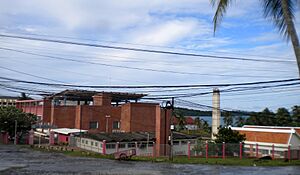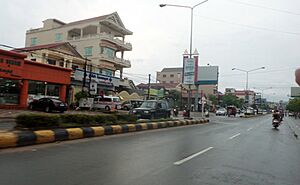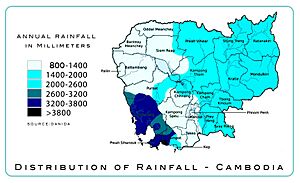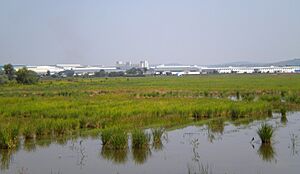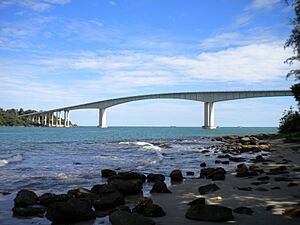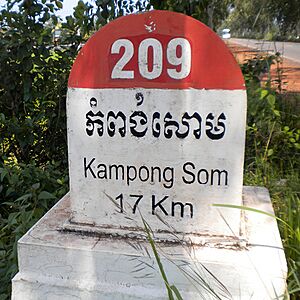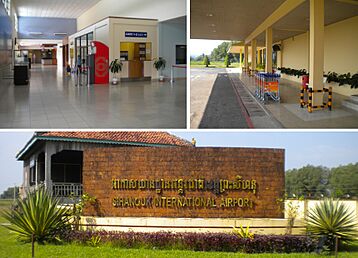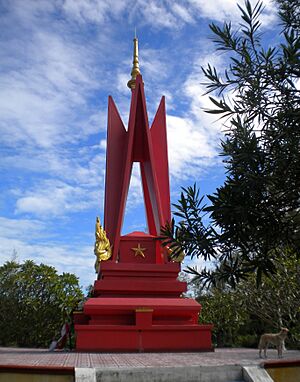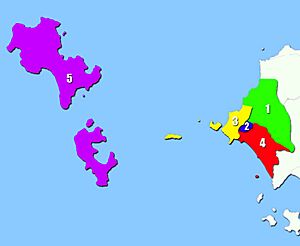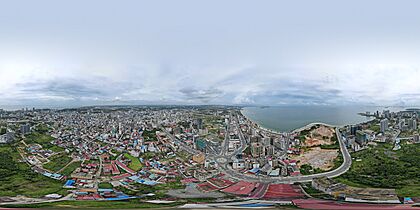Sihanoukville facts for kids
Quick facts for kids
Sihanoukville
ក្រុងព្រះសីហនុ
|
|
|---|---|
|
Clockwise from top: Sihanoukville Skyline; Jin Bei Casino; Ochheuteal Beach; Aerial View of Beaches in Sihanoukville; Otrest Beach; Bird's Eye View of Golden Lions Roundabout; and Statue of Preah Thong Neang Neak
|
|

Sihanoukville city's urban area (yellow)
in Sihanoukville Municipality (red) and Sihanoukville Province (purple) |
|
| Country | |
| Province | Preah Sihanouk |
| Municipality | Preah Sihanouk |
| Established | 22 November 1957 |
| Named for | Norodom Sihanouk |
| Area | |
| • Total | 195.9 km2 (75.6 sq mi) |
| Elevation | 15 m (45 ft) |
| Population
(2019)
|
|
| • Total | |
| • Rank | 7th |
| • Urban | |
| • Urban density | 834/km2 (2,160/sq mi) |
| • Municipality | |
| Time zone | UTC+7 (ICT) |
| Postal code |
18000
|
| Area code(s) | 034 |
Sihanoukville (Khmer: ក្រុងព្រះសីហនុ, Krŏng Preăh Seihănŭ), also known as Kampong Saom (Khmer: កំពង់សោម, Kâmpóng Saôm), is a city on the coast of Cambodia. It is the capital of Preah Sihanouk Province. The city sits on a peninsula in the country's southwest, facing the Gulf of Thailand.
Sihanoukville is famous for its many beaches along the coastline. It also has coastal marshlands next to Ream National Park in the east. The city has one river, the Ou Trojak Jet, which flows from Otres Pagoda to the sea. Several small islands, managed by Sihanoukville, are close by.
The city was named after the former king, Norodom Sihanouk. In 2008, about 89,800 people lived in Sihanoukville, with around 66,700 in its main urban area. The city includes most of six areas called Sangkats in Sihanoukville Province. It grew because of the Sihanoukville Autonomous Port, which started being built in 1955. This port is Cambodia's main way to trade by sea without limits. It is the only deep-water port in Cambodia. Sihanoukville has also become Cambodia's top spot for coastal tourism.
Contents
- City Names: Etymology
- A Look Back: History
- City Layout: Geography
- City Environment
- Weather: Climate
- Money Matters: Economy
- Getting Around: Transport
- People of Sihanoukville: Demographics
- Local Life: Culture
- How the City is Run: Administration
- Beliefs: Religion
- Images for kids
- Learning: Education
- Global Connections: International Relations
City Names: Etymology
The official name of the city in Khmer is Krong Preah Sihanouk. Krong means 'city', preah means 'holy', and Sihanouk is the name of the former king. So, the name means "City of the Holy Sihanouk" or "Honorable Sihanouk City". King Norodom Sihanouk is seen as the father of modern Cambodia. The name Sihanouk comes from old words meaning 'lion' and 'jaws'.
The other name, Kompong Saom, means 'Port of the Moon' or 'Shiva's Port'. Saom comes from an old word for 'moon'. Kampong means 'village' or 'hamlet' in Malay, but here it means 'pier' or 'landing bridge'.
A Look Back: History
Early Times (Before 1700)
Before the port was built in 1955, Kompong Som was not a very important port. This was because there were no easy ways to travel by water from the port to the main cities of the kingdom. In ancient times, trade was mostly done at O Keo in the Mekong Delta.
An old Cambodian book from the 1700s and 1800s mentions the region. It says that in 1479, a king named Dhammaraja controlled areas including Kompong Saom.
Modern Era (1700s–1863)
By the end of the 1600s, Cambodia lost control of the Mekong River trade route. This happened as Vietnam grew stronger in the lower Mekong area. In 1717, a Siamese fleet burned the port of Kompong Som.
Later, in 1757, the ports of Kampot and Kompong Som were given to a Chinese pirate named Mac-Thien-Tu. He helped the King of Cambodia. This port became a duty-free trading center until it was destroyed in 1771.
Alexander Hamilton, who visited in 1720, wrote that Kompong Som belonged to Cambodia. Kampot remained Cambodia's only international seaport.
French Rule (1863–1954)
Under French rule, Vietnam, Laos, and Cambodia were managed as one area. Building another big trading center near Saigon was not seen as needed. The focus stayed on the Mekong River.
An uprising from 1885 to 1887 also made the French less interested in building a new port. This uprising started in Kampot and spread to Kompong Som.
One improvement during this time was the building of Route Coloniale No. 17, which is now National Road No.3. Work on the railway line from Phnom Penh to Sihanoukville only started in 1960.
After Independence (Since 1954)
After France left in 1954, Cambodia needed its own way to access the sea. Plans were made to build a new deep-water port. Kompong Saom was chosen because of its deep water and easy access. In 1955, construction began. France provided money for the port, and the United States funded the road.
During the Vietnam War, the port was used by both sides. It was the last place the US Army left before the Khmer Rouge took control in 1975. After the Khmer Rouge regime fell in 1979, the port became important again for Cambodia's recovery.
In 1993, Ream National Park was created. In 2008, Sihanoukville became a province. In the early 2000s, Sihanoukville grew into a center for trade, transport, and manufacturing. Its many beaches and nearby islands make it Cambodia's best seaside resort.
In 2011, the Preah Sihanouk area joined the "Most Beautiful Bays in the World" club. By 2019, Chinese investments changed the city a lot. Many businesses became owned by Chinese nationals.
City Layout: Geography
Land Features
Sihanoukville is located on a peninsula with rolling hills. The city center is about 15 metres (49 ft) above sea level. The land gently slopes down to wide coastal plains, marshlands, and beaches in the south. The Gulf of Thailand has shallow waters and a mild climate.
Buildings and City Look
Sihanoukville was built after the French Protectorate period. So, it does not have the old French colonial style buildings seen in other Cambodian cities. Cambodian architect Vann Molyvann designed many public buildings here. This style, called New Khmer Architecture, lasted until 1970.
The first city plan in 1959 included bike paths and green spaces. It also set aside areas for the port, railway, city center, and a tourist zone along the beaches.
Rivers
The Ou Trojak Jet River is Sihanoukville's longest river. It flows from Otres Pagoda to Otres Beach. This river is lined with mangrove trees. You can find fish like Barramundi and barracuda here. Restaurants along the river serve fresh seafood.
Islands
All the islands near Sihanoukville are managed by the city's Mittakpheap District. Most of them are being developed for tourism. Koh Rong and Koh Rong Sanloem are especially popular.
- Koh Rong: This is the largest island, about 26 km (16 mi) west of Sihanoukville. It covers 78 km2 (30 sq mi). It has hills, with a 316 metres (1,037 ft) mountain, and is mostly covered in forest. Ferries run between Sihanoukville and Koh Rong.
- Koh Rong Sanloem: South of Koh Rong, this island has beaches on its west and east coasts. It is also covered in dense forest. Ferries also connect Sihanoukville to Koh Rong Sanloem.
- Koh Puos: Also called 'Snake Island' or 'Morakot Island'. It is 800 metres (2,625 ft) from Victory Beach. It is being developed into a luxury holiday spot and is connected to the mainland by a bridge.
- Koh Dek Koul: A small island 7 kilometres (4 mi) from Victory Beach.
- Koh Bong Po-oun/Song Saa: These are two tiny islands off Koh Rong's north-east, now called Koh Song Saa.
City Environment
The city's water supply faces pollution issues. Also, how waste is managed needs improvement.
Weather: Climate
Sihanoukville has a tropical monsoon climate. This means it has two main seasons: a wet season and a dry season.
The average maximum temperature is about 30 °C (86 °F), and the average minimum is about 24 °C (75 °F). Temperatures can go above 32 °C (90 °F), and sometimes even over 38 °C (100 °F) before the rainy season starts. The coldest month is January, where night temperatures can drop below 20 °C (68 °F).
The city gets about 2,200 millimeters (86.6 inches) of rain each year. Most of the rain falls in July, August, and September. The air is very humid all year, usually over 90 percent. During the dry season, humidity is around 50 percent, but it climbs to about 90 percent in the rainy season. The wet season is from April to November, and the dry season is from December to March. Even in the dry season, there can still be some rain.
| Climate data for Sihanoukville, Cambodia | |||||||||||||
|---|---|---|---|---|---|---|---|---|---|---|---|---|---|
| Month | Jan | Feb | Mar | Apr | May | Jun | Jul | Aug | Sep | Oct | Nov | Dec | Year |
| Mean daily maximum °C (°F) | 31.3 (88.3) |
31.2 (88.2) |
32.1 (89.8) |
33.7 (92.7) |
32.3 (90.1) |
31.2 (88.2) |
30.0 (86.0) |
30.8 (87.4) |
30.8 (87.4) |
30.8 (87.4) |
31.2 (88.2) |
31.7 (89.1) |
31.4 (88.6) |
| Mean daily minimum °C (°F) | 23.9 (75.0) |
24.6 (76.3) |
25.4 (77.7) |
25.0 (77.0) |
26.8 (80.2) |
26.3 (79.3) |
25.9 (78.6) |
25.1 (77.2) |
25.2 (77.4) |
24.7 (76.5) |
24.4 (75.9) |
23.5 (74.3) |
25.1 (77.1) |
| Average precipitation mm (inches) | 28.3 (1.11) |
25.2 (0.99) |
50.3 (1.98) |
124.8 (4.91) |
207.3 (8.16) |
252.7 (9.95) |
341.4 (13.44) |
377.2 (14.85) |
320.6 (12.62) |
290.4 (11.43) |
138.2 (5.44) |
54.4 (2.14) |
2,210.8 (87.02) |
| Source: world weather online | |||||||||||||
Money Matters: Economy
Sihanoukville's economy mainly depends on its deep-water port and the nearby oil terminal. The port has modern cargo storage and logistics facilities. These serve many shipping companies and businesses. The route between Phnom Penh and Sihanoukville is Cambodia's most important trade route. It handles about 75 percent of the country's trade.
Other big parts of the city's economy include fishing, seafood processing, and the clothing industry. Food production and processing are also important. The tourism industry is growing steadily, which also helps the local real estate market.
Sihanoukville Special Economic Zone
The Sihanoukville Special Economic Zone (SSEZ) is an area set up to help businesses grow. It started by focusing on making consumer goods. Now, it aims to produce machinery, solar panel materials, and chemicals. This zone has received support from China. By March 2020, the SSEZ had 174 factories. These factories employed over 30,000 people.
Trade
Today, the city's main export is clothing. It also exports timber, logs, and rubber.
Cambodia has increased its exports a lot since joining the World Trade Organization (WTO) in 2004. The United States is Cambodia's biggest trading partner.
Future of the Economy
An industrial zone has been created. It includes making petrochemicals and processing food from local fisheries.
Foreign investment in Cambodia has grown a lot since 2004. Investors from countries like Malaysia, China, and Thailand have led this growth. Chinese investments have changed the city's look and feel.
Sihanoukville Port Special Economic Zone
The Sihanoukville Autonomous Port is managed on its own. It is the main part of the city's economy, along with logistics and transport.
The port covers about 124.76 hectares. The Old Jetty was built in 1956 and started working in 1960. It is 290 metres (950 feet) long and can hold four ships. A new quay, 350 m (1,148 ft) long, was built in 1966. The container terminal was finished in 2007.
| Sihanoukville Autonomous Port Traffic Rates | ||||||||||||||
| Item | 2003 | 2004 | 2005 | 2006 | 2007 | 2008 | 9M2009 | |||||||
|---|---|---|---|---|---|---|---|---|---|---|---|---|---|---|
| Gross Throughput (Tons) | 1,772,361 | 1,503,050 | 1,380,847 | 1,586,791 | 1,818,877 | 2,057,967 | 1,405,338 | |||||||
| Not Included Fuel | 1,454,856 | 1,242,011 | 1,131,699 | 1,320,102 | 1,428,992 | 1,605,672 | 958,279 | |||||||
| Not Include Fuel &Cont. | 650,329 | 308,153 | 107,929 | 197,573 | 193,573 | 291,114 | 162,520 | |||||||
| Cargo containerized | 804,527 | 933,858 | 1,023,770 | 1,122,529 | 1,235,419 | 1,314,559 | 795,759 | |||||||
| Container throughput (TEUs) | 181,286 | 213,916 | 211,141 | 231,036 | 253,271 | 258,775 | 157,639 | |||||||
| Vessel calling (units) | 878 | 730 | 686 | 912 | 876 | 954 | 642 | |||||||
The main places Sihanoukville Autonomous Port sends goods to are Singapore, Hong Kong, Bangkok, and Ho Chi Minh City.
Getting Around: Transport
Roads and Streets
- Phnom Penh-Sihanoukville Expressway: A new major expressway connects Sihanoukville and Phnom Penh. It opened in October 2022. China helped build this road as part of its Belt and Road Initiative.
- National Highway 4 (NH4): This road connects Phnom Penh and Sihanoukville. The United States helped build it for heavy trucks. It is about 250 km (155 mi) long.
- National Highway 3: This road links Sihanoukville with Kampot Province. It was improved in 2008. It is part of a larger economic route from China to Thailand.
- National Highway 48: This road connects Sihanoukville and Phnom Penh with Koh Kong Province. It goes all the way to the border with Thailand.
City Traffic
In Cambodia, people drive on the right side of the road. There are many motorbikes in the city because there is no public transportation or taxi cars. Many motorbike drivers do not wear helmets. It is common to see more than two people on a motorbike.
The main bus station for long-distance travel is on National Highway 4. Many companies offer daily bus services. Private taxis are also available for longer trips.
The city does not have public transportation like buses or trains within the city. There are motor-taxis (moto-dups) and tuk-tuks for local travel.
Airport
Sihanouk International Airport (KOS) is located in Ream Commune. It is about 18 kilometres (11 miles) from Sihanoukville City. As of July 2019, there were almost 200 flights from China to Sihanoukville every week.
Marine Transport
The daily ferry service between Sihanoukville and Krong Koh Kong stopped in 2007. This was after National Highway 48 was completed.
However, Koh Rong Island and Koh Rong Sanloem Island still have daily ferry services. Marina Oceania is the first marina in Cambodia. It opened in 2013 for yachts and boats.
Rail Transport
Cambodia's railway network has been rebuilt for moving goods. The "Southern line" connects Sihanoukville Port Special Economic Zone with the capital Phnom Penh. This line is 264 km (164 mi) long.
Currently, a daily passenger train runs from the station near the Autonomous Port to Phnom Penh through Kampot.
People of Sihanoukville: Demographics

The people living in Sihanoukville are a mix of different groups. Many are descendants of the original inhabitants. There are also people from the Cambodian diaspora and those who came after the Pol Pot era. Over time, many non-Khmer people from other Asian countries have moved to the city. In 2008, the city had 89,846 residents.
| Year | 2008 | 2009 | 2010 | 2011 | 2012 | 2013 | 2014 | 2015 | 2016 |
|---|---|---|---|---|---|---|---|---|---|
| Total | 229,205 | 235,095 | 241,154 | 247,355 | 253,654 | 260,034 | 266,470 | 272,933 | 279,419 |
| Male | 114,680 | 117,735 | 120,872 | 124,076 | 127,324 | 130,607 | 133,913 | 137,227 | 140,545 |
| Female | 114,525 | 117,360 | 120,282 | 123,279 | 126,330 | 129,427 | 132,557 | 135,706 | 138,874 |
| Annual growth | 2.57 | 2.58 | 2.57 | 2.55 | 2.52 | 2.47 | 2.43 | 2.38 | |
| Sex ratio | 100.1 | 100.3 | 100.5 | 100.6 | 100.9 | 101.0 | 101.1 | 101.2 | 101.3 |
| Median age | 21.8 | 22.3 | 22.8 | 23.3 | 23.7 | 24.2 | 24.7 | 25.1 | 25.6 |
Besides Khmer, groups like Vietnamese, Chinese, Cham, Thai, Korean, French, British, Europeans, Australians, and Americans live in the city. Sihanoukville has a higher Human Development Index (HDI) than the national average.
In late 2018, it was estimated that the Chinese population in the province grew to 78,000. By 2019, Chinese workers and investors made up 90% of the city's foreign population. Mandarin signs are becoming more common than Khmer and English signs. Sihanoukville is an important city for China's One Belt One Road Initiative.
Local Life: Culture
Most people in Sihanoukville are of East Asian descent. This means their beliefs and ideas are often from East Asian cultures. Cambodian culture comes from ancient Khmer traditions, with some Chinese and Vietnamese influences over the centuries.
People in Sihanoukville celebrate many festivals. These include Cambodian New Year (April), Chinese New Year (January/February), Water Festival (November), and Pchum Ben (a festival to honor ancestors in October).
Many Chinese or Sino-Khmer families in Sihanoukville have historically been important in business. They often follow Confucian work ethics.
Tourism
Sihanoukville has about 150 hotels and many guesthouses. As a tropical seaside resort, the city's nightlife is shaped by its many beaches. The main tourist area is between the Golden Lion Plaza and the Ochheuteal/Serendipity Beaches.
How the City is Run: Administration
Sihanoukville is the capital of Sihanoukville province. It is governed by its deputy governor. The city covers most of four of the five areas called Sangkats in Sihanoukville province's Mittakpheap District. The port has its own separate management. These Sangkats are divided into 19 villages.
| The communes of Mittakpheap District | |||||||||||||||||||||
|---|---|---|---|---|---|---|---|---|---|---|---|---|---|---|---|---|---|---|---|---|---|
| ISO Code | Commune | Romanization | Population | Sections | Urban | ||||||||||||||||
| 1801-1 | សង្កាត់ មួយ | Sangkat 1 | 37,440 | 3 | Yes | ||||||||||||||||
| 1801-2 | សង្កាត់ ពីរ | Sangkat 2 | 25,142 | 3 | Yes | ||||||||||||||||
| 1801-3 | ស្ទឹងហាវ បី | Sangkat 3 | 13,108 | 3 | Majority | ||||||||||||||||
| 1801-4 | សង្កាត់ បួន | Sangkat 4 | 13,108 | 6 | Majority | ||||||||||||||||
| 1801-5 | សង្កាត់ កោះរ៉ុង | Sangkat Koh Rong | 1,108 | 4 | No | ||||||||||||||||
Autonomous Port
Sihanoukville Autonomous Port is in Sangkat 1. It covers about 124.76 hectares (308.3 acres). The port is 18 kilometres (11 mi) from the airport and 4 kilometres (2.5 miles) from the city center. Ship passengers can visit Sihanoukville town. The port terminal has restrooms, restaurants, ATMs, and stores.
Kampong Seila
Kampong Seila district used to be part of Koh Kong Province. In January 2009, it was moved to Sihanoukville Province. This change helped adjust the borders of the provinces.
Beliefs: Religion
Theravada Buddhism is the main religion in Cambodia. The city has several important pagodas (Buddhist temples):
- Upper Pagoda (Wat Chotynieng or Wat Leu): This pagoda is on a hill overlooking Sihanoukville bay. It is dedicated to Samdech Preah Sangareach Chhoun Nath, a Cambodian Buddhist leader.
- Lower Pagoda (Wat Krom): This pagoda is in Sihanoukville town. It is dedicated to Yeay Mao, a popular ancestral spirit in southern Cambodia.
- O'tres Pagoda (Wat Otres): Located in Otres village, by the Ou Tro Jet River. It has a water garden and sculptures of ancestral spirits.
Sihanoukville also has smaller communities of other religions. These include Catholics, Muslims, Protestants, and Taoists. Places of worship include:
- St. Michael's Church: This is the main church for Catholic communities. Sailors built it in 1960. It is on the same hill as the Upper Pagoda.
- Iber Bikhalifah Mosque: This is the religious center for the local Muslim community. It is in the busy Psah Leu (upper market) area of Sihanoukville town.
| Religion in Cambodia | ||||
|---|---|---|---|---|
| Religion | percent | |||
| Theravada Buddhism | 92% | |||
| Mahayana Buddhism | 3% | |||
| Islam | 1.6% | |||
| Christianity | 0.2% | |||
| Others | 3.2% | |||
Images for kids
-
St. Michael Catholic Church.
Learning: Education
In 2010, Cambodia spent 2.6% of its GDP on education. Cambodian schools follow a national curriculum.
- Basic Education
This includes three cycles, each lasting three years.
- First cycle (grades 1–3): Students have 27–30 lessons per week, each 40 minutes long. They focus on five main subjects.
- Second cycle (grades 4–6): Similar to the first cycle, with the same number of lessons.
- Third cycle (grades 7–9): Students have 32–35 lessons, focusing on seven major subjects.
- Upper Secondary Education
This has two phases.
- First phase (grade 10): The curriculum is like the third cycle of basic education.
- Second phase (grades 11–12): This phase has required subjects and elective (optional) subjects.
The adult literacy rate in Sihanoukville is 95.37%.
The city used to have a shortage of teachers, but this has improved. In 2004, there were:
- 33 pre-schools with 1,670 children.
- 52 primary schools with 34,863 students.
- Five colleges with 4,794 students.
- Two high schools with 1,449 students.
- 10 vocational training schools with 961 students.
- 13,728 students in private schools.
Global Connections: International Relations
Sihanoukville is twinned with these cities:






